
India has seen a wave of national reforms during the three consecutive terms of its prime minister, Narendra Damodardas Modi.
One sector – and perhaps the most important one – is education. More than ever, the children of India have access to many doors previously unopened, thanks to the establishment of new programmes and initiatives to support their learning.
But how did this reform begin? The education of Narendra Modi, the leader of India, could provide some insight.

According to people who knew him as a child, Modi enjoyed books and co-curricular activities over academics. Source: AFP
The education of Narendra Modi
Modi was born in 1950, three years after India gained its independence, making him the first prime minister born in this new era.
The third of six children, Modi was raised in a small town in northern Gujarat and spent his early life working at his family’s tea stall.
It was a struggle making ends meet, but he still found time to visit the local library to read books. Even as a child, he displayed a strong interest in debating, especially on topics involving patriotism and nationalism.
“I was a very ordinary student,” he said during an interview with entrepreneur and investor Nikhil Kamath.
“I was not noticeable in any way, but one of my teachers, Bheljibhai Chaudhary, used to encourage me a lot. One day, he told my father — ‘He is so talented, but he does not focus.’” he said, adding that “but if exams had a competition element, I used to run away from it.”
But what he lacked in academics, he made up for in heart.

As a child, Modi was kind to everyone around him, even animals. Source: AFP
According to the book “Modi: Common Man’s PM – Understanding India’s Popular Leader” by Kishor Makwana, Modi’s teacher thought of him as an average student, but he was always willing to help those weaker than him.
During his studies, Modi never accepted any wrongdoing, regardless of whether it involved a teacher or a student. One example was when one of Modi’s classmates had been beaten by his teachers, Modi joined his classmates in protesting, preventing the teacher from entering the classroom by sitting outside it until the principal resolved the issue.
Another teacher, Kanhaiya Lak Bhoodar Das Bhausa, described an incident where Modi determinedly saved an injured bird stuck on a tree, ignoring others who were advising him to use a ladder. After treating its wound, Modi climbed back up the tree to return the bird to its perch, preventing animals from killing it.
Throughout his education, Modi inspired others around him to step up and help those in need.
But he wanted to do more.

Modi has a bachelor’s and master’s in Political Science from the University of Delhi. Source: AFP
After completing school, he left home for two years to travel across India, learning more about the country’s challenges and visiting places of spiritual worship, such as the Himalayas, Belur Math in West Bengal, Ramakrishna Ashram in Almora, and more.
Upon returning, he decided to pursue a Bachelor’s in Political Science at the University of Delhi, and then a master’s in the same field at Gujarat University.
Modi also joined Rashtriya Swayamsevak Sangh (RSS) as a bal swayamsevak (junior cadet), a socio-cultural organisation working towards the social and cultural regeneration of India.
This was his first step into the political world – one that eventually resulted in him becoming the 14th prime minister of India.

India has looked to Modi for several years now, with many praising his term as one of the most successful in India’s history. Source: AFP
A visionary for India’s future
Modi recently attended the 2025 Madhya Pradesh Global Investment Summit (GIS) in Bhopal. He delayed his arrival by 15 minutes to avoid disrupting students taking their exams.
“I did not want students to get stuck in traffic, so I decided to adjust my schedule,” he said. “Education should never be obstructed as it is the greatest investment in life.”
Modi has carried that belief with him throughout his three terms as India’s prime minister. He has always shown great consideration to the country’s students and their needs, establishing several programmes to motivate and encourage every child to pursue education consistently.
The National Education Policy 2020, which was signed off by Modi, has been a monumental shift in the country’s education sector, hailed for its proposed reforms in school and higher education across India.
The policy proposes improved basic learning, changing school structures, four-year interdisciplinary undergraduate programmes, and internationalising education in the country – all in hopes of turning India into a global education hub.
A recent programme aims to bridge the rural-urban divide by expanding broadband access under the BharatNet initiative, hoping to increase e-learning, virtual labs, telemedicine, and electronic health records to provide quality education and healthcare accessibility.
As the world’s most populous country, this push for education sets a precedent for global hiring trends. India is one of the world’s top sources of international talent, surpassing China in terms of students going abroad to the US.

Modi recently met with New Zealand Prime Minister Christopher Luxon to discuss strengthening the two countries’ relationship. Source: AFP
As a result, more and more Indian talent are going global. The “Global Skill Gap Study” by the National Skill Development Corporation shows a growing demand for Indian talent across diverse sectors worldwide; over 18 million Indians leave the country to study and find work abroad.
Many look towards India to fill the gaps. Countries are eager to hire Indian professionals, particularly those skilled in the tech, healthcare and old age care sectors, to replace labour shortages due to ageing populations.
Germany, for example, is stepping up its efforts to attract Indian workers, exploring measures like raising the number of skilled labour visas and investing in training in vocational courses. The number of Indian workers in the country doubled between 2021 and 2024, reaching nearly 140,000, with one-third being women.
Narendra Modi on education in India
Aside from thinking that education is the greatest investment in life, Modi has shared other thoughts as well.
Skilling, reskilling, and upskilling
The country is already home to multiple universities that hold top 100 ranking in Asia, such as:
- Indian Institute of Technology Bombay
- Indian Institute of Technology Delhi
- Indian Institute of Technology Madras
- Indian Institute of Science
- Indian Institute of Technology Kharagpur
- Indian Institute of Technology Kanpur
- University of Delhi
The Indian government is opening up over 5,000 industrial training institutes (ITI) nationwide to promote skill development.
Modi called for ensuring India’s youth are ready for continuous reskilling and upskilling to align their competencies with evolving work practices.
“We’re moving to an era where an individual will not be stuck to a single profession all their life,” he said at the Conclave on Transformational Reforms in Higher Education. “Thus, he will continuously need to re-skill and up-skill himself.”
Reinforcing India as a global education hub
Modi is ambitious – he aims to enrol half a million international students into Indian universities by 2047.
The National Education Policy is set to establish branch campuses of international universities in India to retain local talent while attracting students from neighbouring countries who may otherwise choose a Western destination.
“We want to build such an education system in India that youngsters do not need to go abroad to study. In fact, we would want foreign students to come here and study,” he said.
‘A Rising India’
On Teacher’s Day 2022, Modi announced the Pradhan Mantri Schools For Rising India (PM-SHRI) School programme, a government initiative to establish over 14,500 schools nationwide.
This would allow more students to become engaged, productive, and contributing citizens, effectively creating a “rising” India.
“The PM-SHRI schools will have a modern, transformational and holistic method of imparting education,” he said. “Emphasis will be on a discovery-oriented, learning centric way of teaching. Focus will also be on modern infrastructure, including the latest technology, smart classrooms, sports and more.”
View this post on Instagram
India’s elite still believe in the power of an overseas education
Even with Modi’s push to retain Indian talent, many of his subordinates still prefer foreign universities over local ones.
Of the 56 ministers in the PM’s Council of Ministers, 12 have sent their children to foreign universities. Here are some notable examples:
Piyush Goyal
Minister of Commerce and Industry Piyush Goyal’s daughter Radhika graduated from Harvard University in 2019 – her exact degree was not shared online.
Goyal’s son, Dhruv, graduated with a BA in Economics from the same institution and continued on to pursue an MBA as well. He was the first international student elected as Vice President of Harvard’s student body.
Nirmala Sithara
As the daughter of the first female Minister of Finance and Corporate Affairs of India, Vangmayi Parakala holds a bachelor’s and master’s degree in English Literature from the University of Delhi.
She then chose to go abroad, pursuing a master’s in journalism from Northwestern University in the US.
Shivraj Singh Chouhan
Shivraj Singh Chouhan, the Minister of Agriculture and Farmers Welfare of India, sent his son, Kartikey Singh Chouhan, abroad to pursue law at the University of Pennsylvania. He graduated from the LLM programme in 2022.
Later on, he married Amanat Bansal, the daughter of businessman Anupam Bansal and Ruchita Bansal, who holds a master’s in psychology from the University of Oxford.










